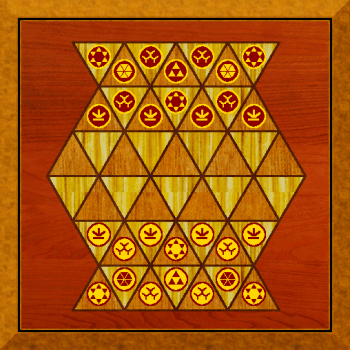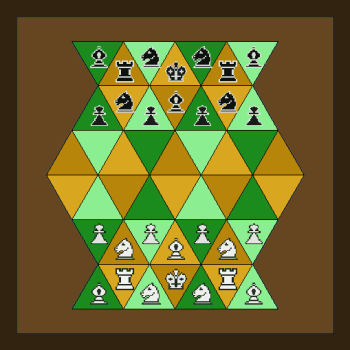Step and Circle TrigChess
This is my trigonal chess entry for the 45 or 46 cell 2007 design competiton.  It uses short range step pieces and sliders with curved paths on an amphora shaped board.Setup
| The board is constructed from 46
equilateral triangles (trigons or trigs) arranged in 6 ranks;
the two centre-ranks having 9 files each, with the outer four having 7. Each player has 14 pieces consisting of:
|
 |
Pieces
|
The King may move a single step to any one of the 3 adjacent edge-conneccted trigs provided that trig is safe (not atttacked by an enemy piece). In the image on the right these 3 adjacent trigs are indicated by grey dots. The King has no special castle move. |
 |
The Dome moves in a series of up to 5 steps,
each to an adjacent edge-connected trig, making a sixty-degree turn in
a constant direction between each step.
The Dome will thus follow a tight circular path, the full 5 steps plus the starting trig forming a hexagon. In the image on the right the 12 reachable trigs are indicated by grey dots. The Dome may not leap over other pieces but has 2 possible paths to each destination. Â |
 |
The Gyro moves in a series of up to 5 steps,
each to an adjacent point-connected trig of a different colour, making
a sixty-degree turn in a constant
direction between each step.
Â
The Gyro will thus follow a loose circular path, the full 5 steps plus the starting trig forming the points of a star centred on a hexagon. In the image on the right the reachable trigs are indicated by grey dots. The Gyro may not leap over other pieces. Between them a side's 3 Gyros cover only 35 trigs; the central Gyro covers 11 trigs while the 2 flanking Gyros cover 12 each. |
 |
The Stag makes a 2-step move. The first
step is to an adjacent edge-connected trig; the second is to a
point-connnected adjacent trig of the same colour. Â
The Stag's move must always contain both steps in the given order.  It may not move just a single step nor make the point-connected step first. In the image on the right the maximum 6 reachable trigs are indicated by grey dots. The Stag may not leap over other pieces.  |
 |
The Pawn moves a single step, 1 trig directly
forward to a trig of a different
colour. Once in the opponent's half of the board the Pawn
may also move 1 step sideways, again to a differently coloured
trig.Â
When moving directly forward or sideways the Pawn may not capture and may not leap over other pieces. In the image on the right these moves are shown by grey dots. Pawns capture by moving forward to a trig of the same colour. These possible captures are shown by green dots.. There is no initial double-move and thus no En-Passant capture. Pawns promote on reaching one of the 4 base trigs of the far-most rank, indicated for the gold player by green crosses. |
 |
Rules
There are two players, shown here as Gold and Red.A player wins by checkmating the enemy King or stalemating the opponent.
A player loses if they make a move that results in a board position occurring for the third time.
Turns, consisting of moving a single friendly piece, alternate between the players with Gold going first.
The movement of each piece is detailed above.
Notes
PiecesIf preferred the game may be played with standard chess pieces by using:
The image on the right shows the start position using these pieces on a board coloured to show the Gyro's moves, as suggested in a comment by Abdul-Rahman Sibahi. |
 |
 This 'user submitted' page is a collaboration between the posting user and the Chess Variant Pages. Registered contributors to the Chess Variant Pages have the ability to post their own works, subject to review and editing by the Chess Variant Pages Editorial Staff.
This 'user submitted' page is a collaboration between the posting user and the Chess Variant Pages. Registered contributors to the Chess Variant Pages have the ability to post their own works, subject to review and editing by the Chess Variant Pages Editorial Staff.
By Graeme C Neatham.
Web page created: 2007-11-14. Web page last updated: 2007-11-16
